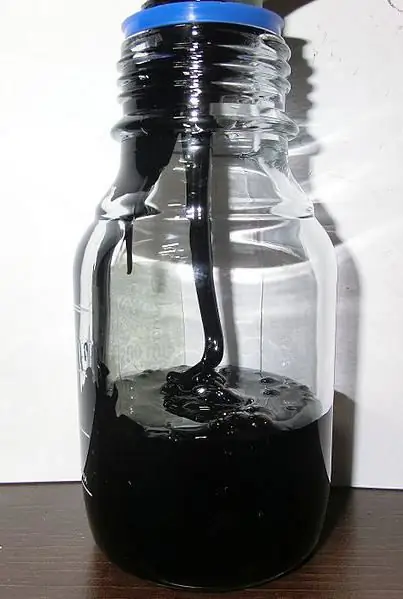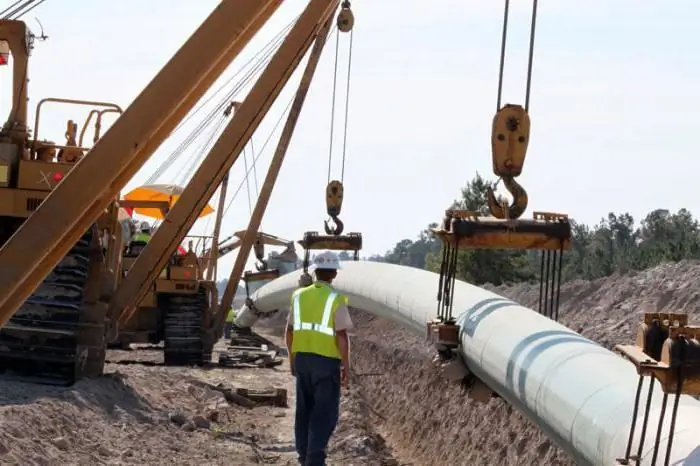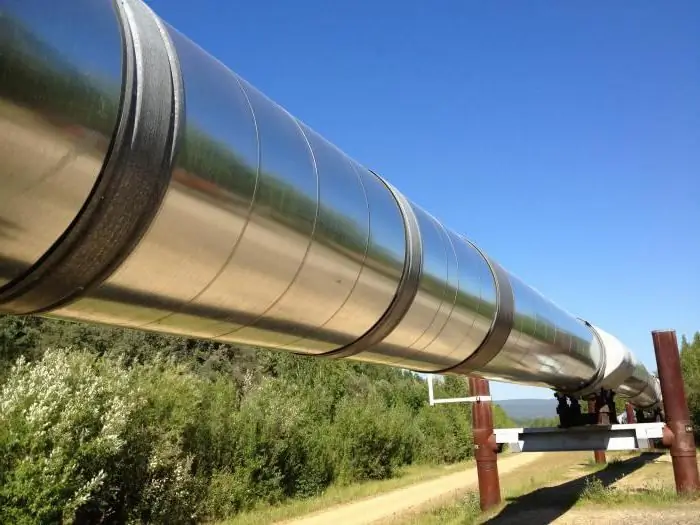2026 Author: Howard Calhoun | [email protected]. Last modified: 2025-06-01 07:12:56
Russian oil pipelines are one of the key components of the fuel and energy sector of the country's economy. Today, the Russian Federation has an extensive network of oil pipelines, gas pipelines and oil product pipelines of various significance. Pipeline transport connects the territories of most subjects of the Federation, and also serves to export hydrocarbons and products of their processing.

Pipeline classification
Pipelines are divided according to their purpose:
- Locals connect facilities within field, oil and gas storage facilities, refineries.
- Regional pipelines have a length of several tens of kilometers. They connect oil fields with the main station, with points for loading oil (loading) on water or rail transport, with a main pipeline.
- Main - pipelines with a length of over 50 km, pipe diameters from 200 mm to 1400 mm and more. The distance that products can be transported through such pipelines is measured in hundreds or thousands of kilometers. Pumping is carried out not by one compressor station, but by several located along the route of the pipeline. Depending on the oil product being pumped, the main pipeline is called an oil pipeline (crude oil pumping), a product pipeline (petroleum products), a fuel oil pipeline, a gasoline pipeline, a kerosene pipeline, etc.
Main pipelines operate continuously, their short-term stop is possible in the event of an accident, repair or scheduled replacement of parts.

Development of oil pipelines in Russia
The history of pipeline development in Russia is inextricably linked with the development of the oil industry. In 1901, almost half of the world's oil production was produced in the state. With the increase in the volume of raw materials, the question of its transportation more and more often arose. To reduce the congestion of railways and reduce the cost of transportation, the economic feasibility of building pipelines was justified.
The first main oil pipelines in Russia with a total length of 1147 km were built at the turn of the 19th and 20th centuries and connected fields in the vicinity of Baku with oil refineries. The initiative to build the first product pipeline belonged to D. I. Mendeleev. The plan was implemented in 1906. The product pipeline with a length of 831 km, a pipe size of 200 mm and 13 compressor stations was the largest in the world at that time and supplied kerosene from Baku to Batumi for subsequent export.
In the pre-war years, the main flows of oil and oil products fell on the Caspian, the Caucasus and the Volga basin. The Grozny-Tuapse (649 km, diameter 273 mm), Ishimbay-Ufa (169 km, 300 mm) oil pipelines and the Mangyshlak-Samara and Ust-Balyk-Almetyevsk oil pipelines were put into operation.
The oil pipelines of Russia (then the USSR) received a new round of development in the post-war years. The peak occurred during the period of rapid development of oil production and refining in the Volga-Ural basin and the development of Siberian fields. Main pipelines of significant length with a diameter of up to 1200 mm were built. Thanks to some of them (for example, Surgut-Polotsk), Siberian oil began to be supplied to the central regions of Russia, Belarus and the B altic States.

Advantages of pipeline transport
The oil and gas pipelines of Russia received the most intensive development in the second half of the 20th century. Today, in terms of the volume and specific gravity of transported hydrocarbons, pipeline transport is steadily replacing rail and water transportation of oil and oil products. The main advantages of oil and gas pipelines are:
- Large transfer distance, smooth operation, substantial throughput, minimal losses.
- Wide viscosity range of pumped petroleum products.
- Stable operation in different climatic zones.
- Possibility of building pipelines in almost any area.
- High level of mechanization withconstruction.
- Automation of process control systems.
The main disadvantage of pipeline transport is considered to be a rather large investment at the construction stage.
Russia's largest oil pipelines
- Baku - Novorossiysk - an oil pipeline for pumping Caspian oil to the port of Novorossiysk.
- Balakhany - Black City is the first oil pipeline in Russia, put into operation in 1878. The pipeline connects the Balakhani field on the Absheron Peninsula and oil refineries in the vicinity of Baku.
- B altic pipeline network. The design capacity is 74 million tons of oil per year. Connects the seaport of Primorsk with oil fields in Western Siberia and the Ural-Volga region.
- Eastern Siberia - Pacific Ocean - a pipeline connecting the Siberian fields with the loading port of Kozmino near Nakhodka. The operator of the oil pipeline is OAO AK Transneft. The length of 4188 km makes it possible to export Russian oil to the markets of the Asia-Pacific region and the USA.
- The Druzhba oil pipeline is the world's largest system of main pipelines built to supply oil and oil products to the socialist states of Eastern Europe. Now operated for export deliveries to Europe.
- Grozny-Tuapse is the first Russian main oil pipeline of medium diameter, built at the beginning of the 20th century to transport Caucasian oil to the Black Sea coast.
- Caspian Pipeline Consortium (CPC)connects fields in western Kazakhstan with a terminal on the Black Sea coast near Novorossiysk.
- The Murmansk pipeline with a capacity of 80 million tons links the oil fields of Western Siberia and the seaport of Murmansk.
- Surgut - Polotsk is an oil pipeline connecting Western Siberia with Belarus and further to the B altic countries and Poland.
- The only heated main oil pipeline Uzen - Atyrau - Samara.

Export via oil pipelines
Currently, Russian oil pipelines account for 84% of oil exported outside the country. The remaining 13% is for rail transport and 3% for water and river transport. OAO AK Transneft is the only oil pipeline operator in Russia. It accounts for 97% of all transported oil produced in the country. The length of the company's pipeline system is more than 217 thousand km, which connects the main oil production regions in Russia with sales markets in Europe. Of the total transport system, 46.7 thousand km are oil pipelines and 19.3 thousand km are oil product pipelines.
Main Russian oil pipelines involved in export:
- B altic oil pipeline, capacity - 74 million tons per year;
- Druzhba pipeline system. One of the branches of this highway goes to Poland, the second - to Slovakia. Total throughput - 90 million tons;
- Black Sea oil pipelines - 43 million tons
The most promising directionfor the development of Russian oil exports is East Siberian, due to the brisk growth of oil consumption in China.
Recommended:
Gas pipeline to China. Project and scheme of a gas pipeline to China

Russia and China have signed a long-awaited gas contract. To whom is it beneficial? Will the fact of its signing affect the geopolitical situation?
Oil is a mineral. Oil deposits. Oil production

Oil is one of the world's most important minerals (hydrocarbon fuel). It is a raw material for the production of fuels, lubricants and other materials
Laying a gas pipeline: methods, equipment, requirements. Gas pipeline security zone

Laying of the gas pipeline can be done by underground and ground methods. When choosing equipment for such systems, safety standards should be followed. Actually, the laying of highways is carried out with strict observance of all the required technologies
Categories of pipelines. Determining the pipeline category. Classification of pipelines by categories and groups

Modern industry cannot do without quality pipelines. There are many types of them. What are the categories of pipelines, how to determine them, is described in the article
How is oil produced? Where is oil produced? Oil price

Currently, it is impossible to imagine the modern world without oil. It is the main source of fuel for various transport, raw materials for the production of various consumer goods, medicines and other things. How is oil produced?

